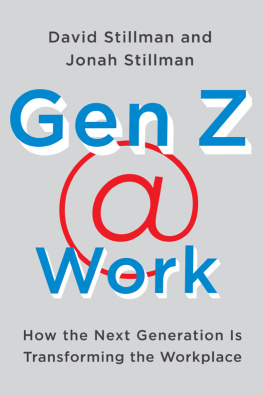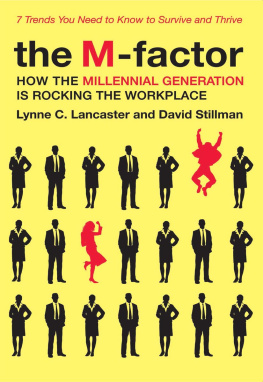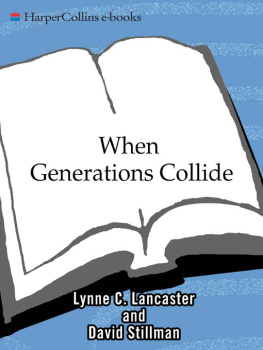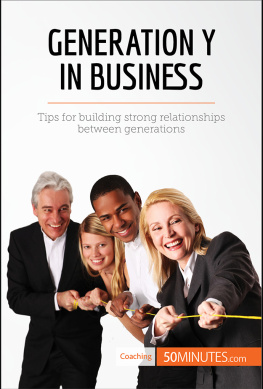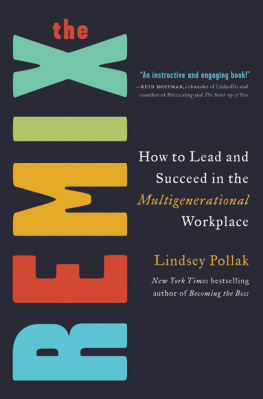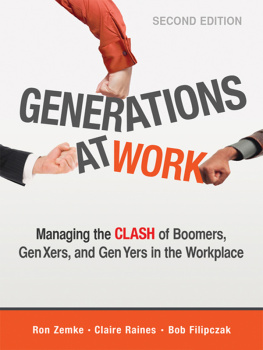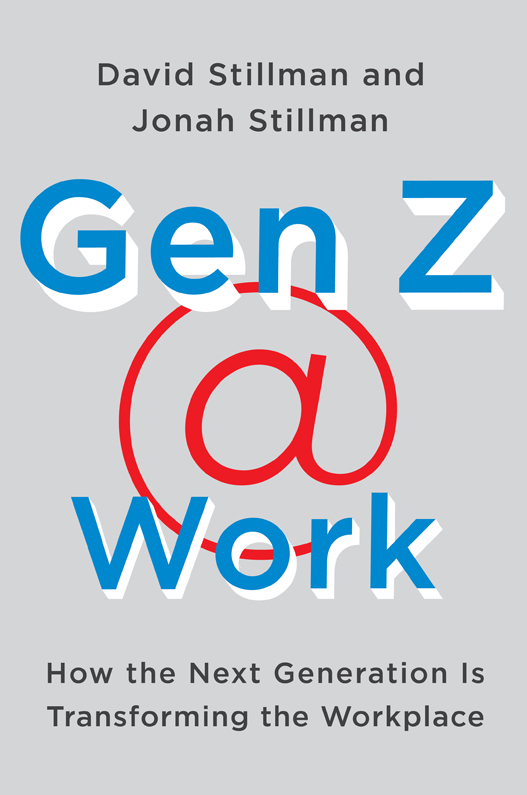This book is dedicated to the late Allan Grosh.
If anyone would be excited to see Gen Z show up
at work, it would be you. Theyre missing out on
a great mentor.
CONTENTS
Guide
A new generation is starting to hit our workforce, yet no one seems to be talking about it. Until now.
Gen Z. Born 19952012.
Usually the first thing people think is, Is that what we are calling them? We can address the name later. In fact, it has its own chapter. For now lets run with it.
We may have thought about Gen Z as consumers and know how to sell them blue jeans or Barbie dolls. However, we have not thought about them as employees and what it will take to recruit, retain, manage, or motivate them.
The other thing most people are thinking: Wait! Arent they Millennials?
No. Theyre not. In fact, they are quite different.
Believe it or not, Millennials have grown up. Beyonc is no longer a single ladyshes an entertainment mogul. Britney and Justin have broken up, moved on, and are even parents. In fact, according to Time magazine, 47 percent of Millennials are moms and dads. Millennials own houses, are done with the college phase, and have launched their careers. There is not a day that goes by where you dont hear something about the Millennials. The most talked-about generation in history. The problem is that we talk about them so much we cant imagine life after the Millennials.
We havent thought about a different generation showing up at the office because it felt so far away. Also, more than just the Millennials, we are focused on the Baby Boomers, who are edging into retirement. We have to be sure all their knowledge and wisdom is captured before its gone. Leaders are also busy still grooming and growing Xers (Gen Zs parents) to take over, a generation whom they have historically ignored or even avoided.
And now there is a whole new generation to get to know? Really?
Yes!
Introducing Gen Z. The leading edge is already in their twenties. At 72.8 million strong, Gen Z are making their presence known in the workplace and organizations and leaders cannot afford to ignore them. The risk in not getting to know Gen Z is that we will simply treat them like the Millennials. Big mistake and its one that weve made before.
When Gen X showed up at work, no one paid attention. In fact, no one had given it any thought. What?! Theres life after the Baby Boomers?! The Boomers garnered the limelight in every marketplace. The workplace spent countless hours designing and implementing rules and regulations, processes, and procedures to help navigate the 80 million Boomers competing to get ahead. It was all Baby Boomer, all the time. When Gen X showed up leaders tried to treat them like the Boomers andKABOOM! Gen X was nothing like the Baby Boomers and from recruiting to career paths to communication and beyond, the workplace was flooded with costly gaps. Even today, companies can feel the pain.
Nothing can stop the arrival of a new generation. The time to get to know Gen Z is today.
However, when I introduce the dialogue about Gen Z hitting the workplace, most of the faces look shocked, mad, exhausted, or confused. They rarely look excited. I definitely sense a feeling of Millennial fatigue out there. As I mentioned, there isnt a day that goes by where we dont hear something about the Millennials. People are just tired of talking about a generation, which definitely does not bode well for Gen Z. However, as I share some results from our national surveys about Gen Z at work, I watch most faces go from mad, exhausted, or confused to relieved, excited, and definitely intrigued.
If anyone is going to be intrigued with a new generation, its probably going to be me.
Allow me to introduce myself. My name is David Stillman.
I have spent close to twenty years researching, writing, and speaking to companies about the topic of generations. It was my full-time job for close to fifteen years. In the mid-1990s, I cofounded a business with a Baby Boomer named Lynne Lancaster. Lynne and I had met while working on a project together at our previous jobs and clashed like no ones business. However, we still liked each other. After the project was done, we went out to lunch to celebrate and talked about our generational differences. We quickly realized that if we were struggling to bridge generational gaps, others were as well. While there were a handful of generational experts out there focusing on a particular generation, we saw a need to pioneer the dialogue about what happens when we put these generations togetherespecially in the workplace.
We quit our jobs shortly after and started our company with the mission of helping Traditionalists, Baby Boomers, Gen Xers, and Millennials bridge the gaps in the workplace and marketplace. Our company took off. The topic was very popular as Xers were shaking up the workplace like never before. Everyone wanted to talk about it. Once we had collected enough primary research, we published our first book, When Generations Collide. We hit the speaking circuit with a vengeance, often speaking together or separately.
Lynne and I did more than just write and talk about the generationswe built a thriving company around our mission of bridging generational gaps. We created a train-the-trainer program, e-learning platform, and even a corporate entertainment show. As Millennials started to enter the workplace, we wrote and published our second book, The M-Factor: How the Millennial Generation Is Rocking the Workplace.
After more than a decade of being on the road, I was tired. Throw in three kids and a germ phobia, and the fun wears off. The opportunity came to sell our business and we took it.
I wasnt sure what I was going to do next when a dear friend and colleague, Marc Kielburger, came to town. He and his brother Craig, whom I met on an airplane, have cofounded the worlds largest global youth empowerment movementcalled WE. My family had supported one of their international programs in Kenya and had gotten to know their organization quite well. We traveled to Kenya multiple times to build schools, and our experiences with the Kielburgers have always been life changing. They were operating WE in eight countries around the world and were ready to bring their program to the United States. Marc knew I had sold my company and asked me to join a team of two others to spearhead their expansion into the States.
My first reaction was that I was not nice enough to work at a nonprofit. I can be quite opinionated, am known to speak my mind, and am not exactly the most patient. I had zero experience working for a nonprofit and other than helping my kids sell wrapping paper for their schools at holiday time, I hadnt done any fund-raising, either.
So, naturally, I took the job.
What I didnt realize was that I would be immersed right back into the generational dialogue. WE gave me my first opportunity to see and work with Gen Z. I was surrounded by incredible teenagers who were taking local and global action to make the world a better place. Collecting coins, doing car washes, bake sales, dance-a-thons, bike rides, hikes... mini businesses. I was so excited by their maturity, sense of self, willingness to work hard, and commitment to service. At the same time, I could see some scary gaps on the horizon as their independent nature would likely clash with collaborative Millennials.
Gen Z entering the workplace resonated even more with me as I have two Gen Z kids who are already working. My oldest daughter, nineteen-year-old Ellie, is a paid intern at the Minnesota Department of Education, and my seventeen-year-old son, Jonah, is my business partner. More on that later. My nine-year-old daughter, Sadie, has bigger plans of being the next singer-songwriter YouTube sensation. Youll be the first to know.

